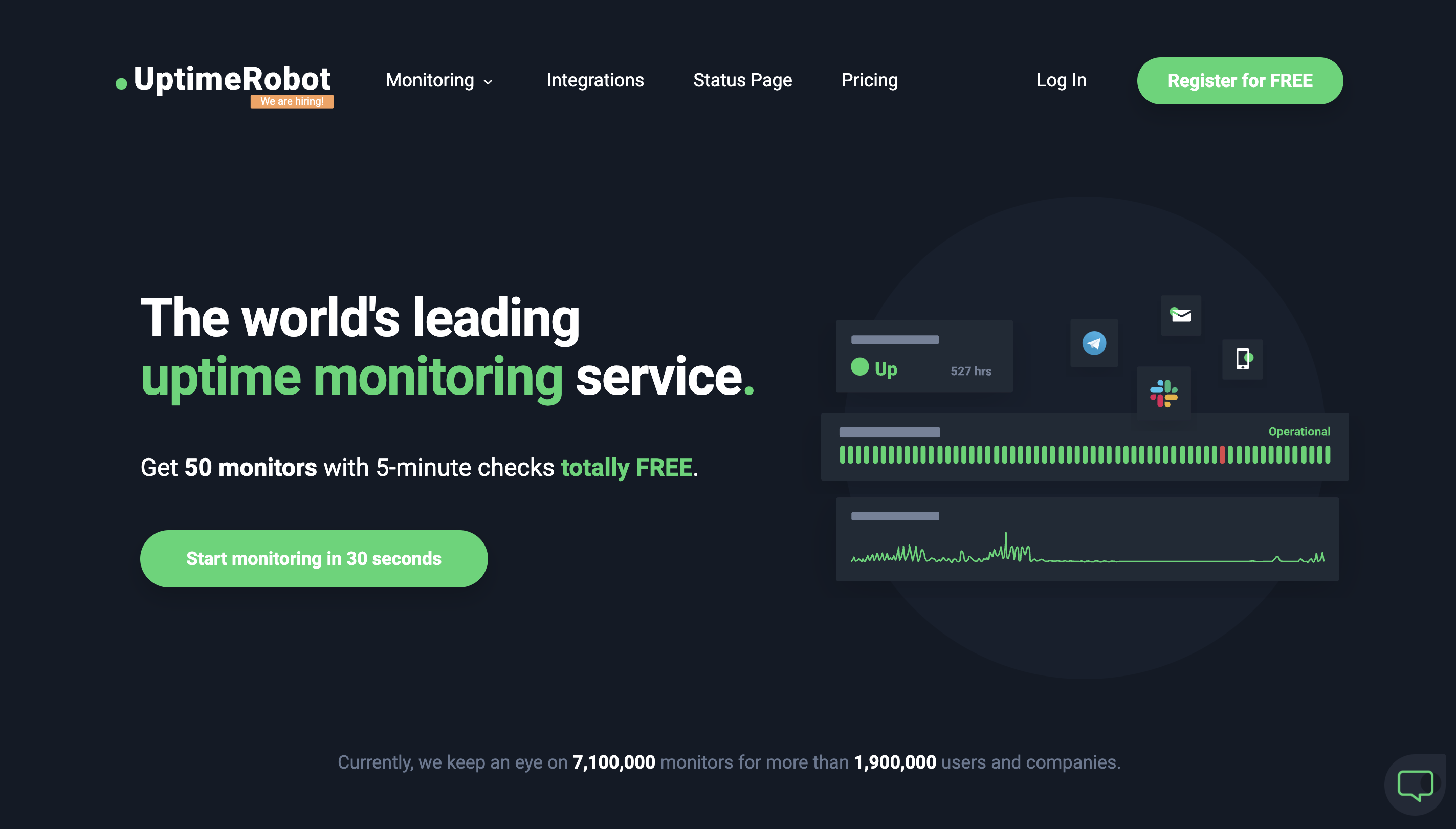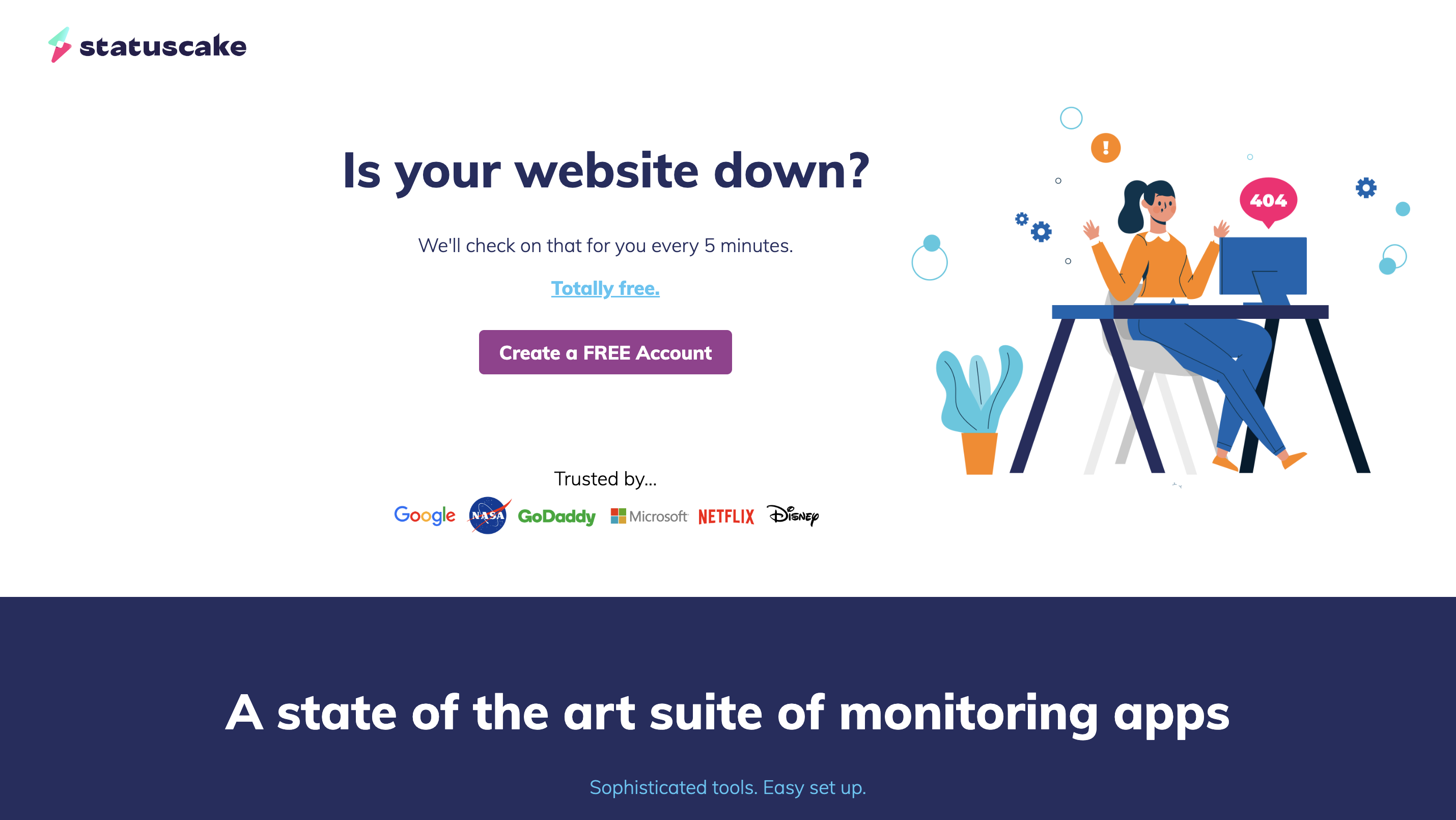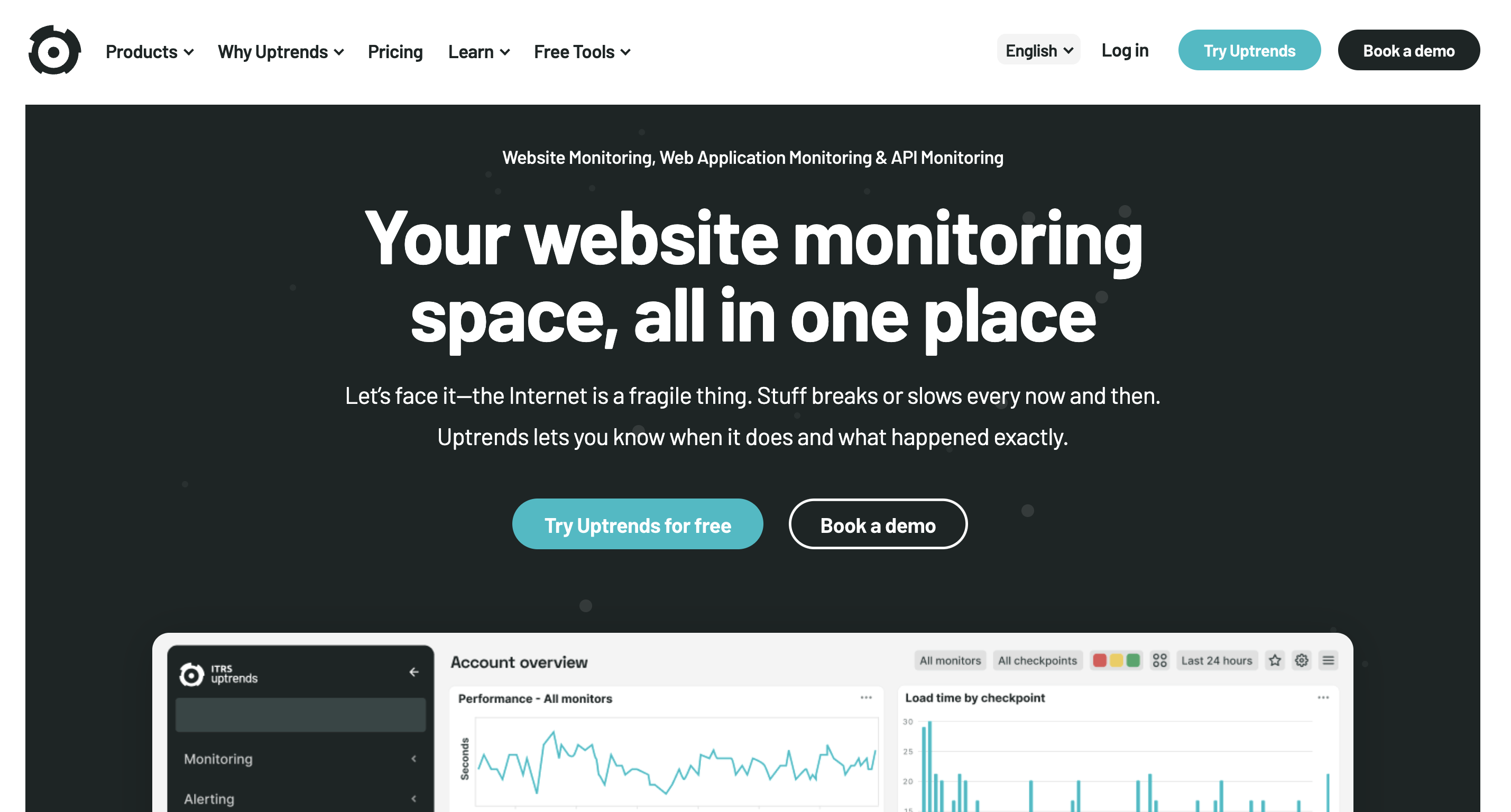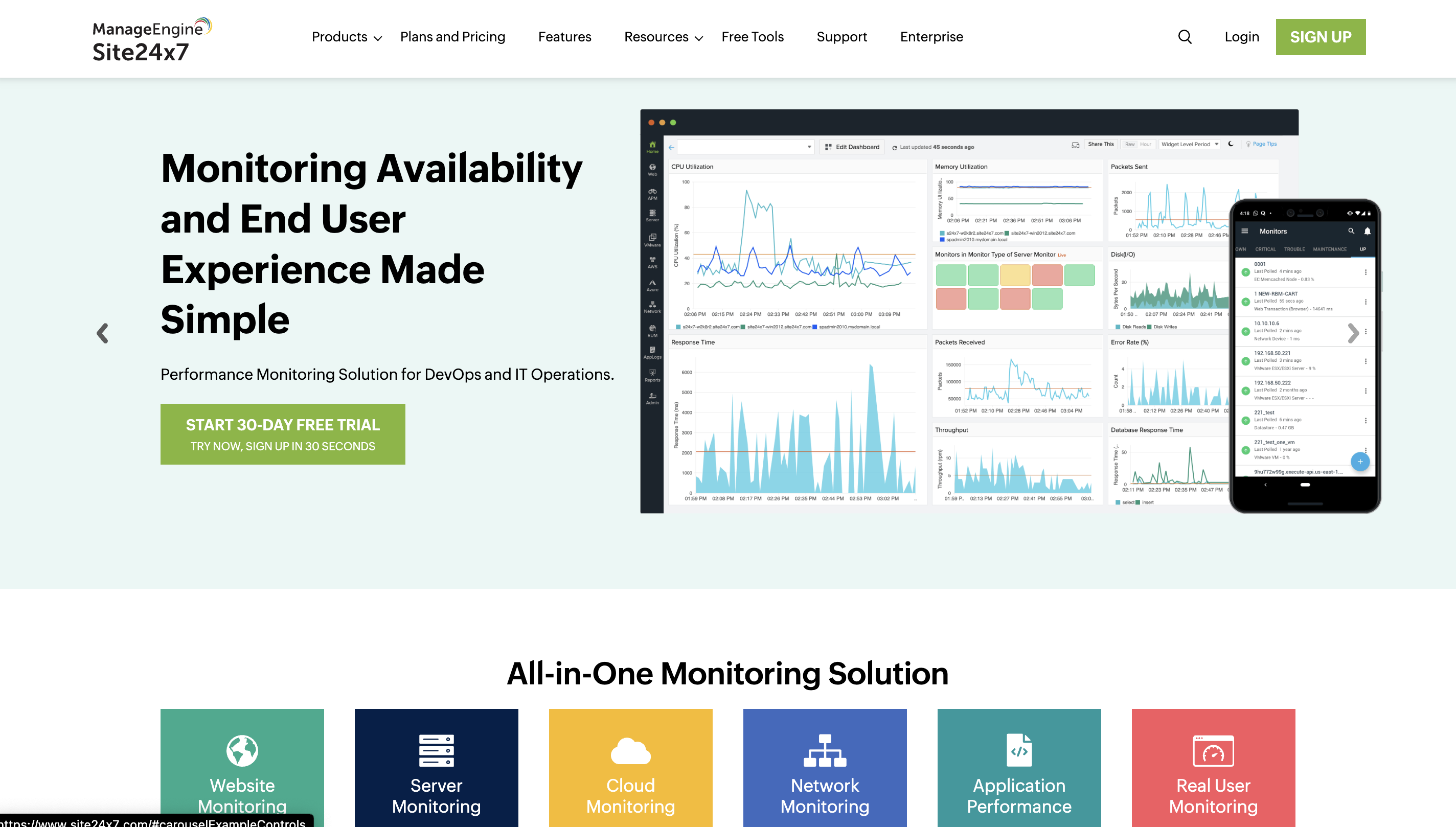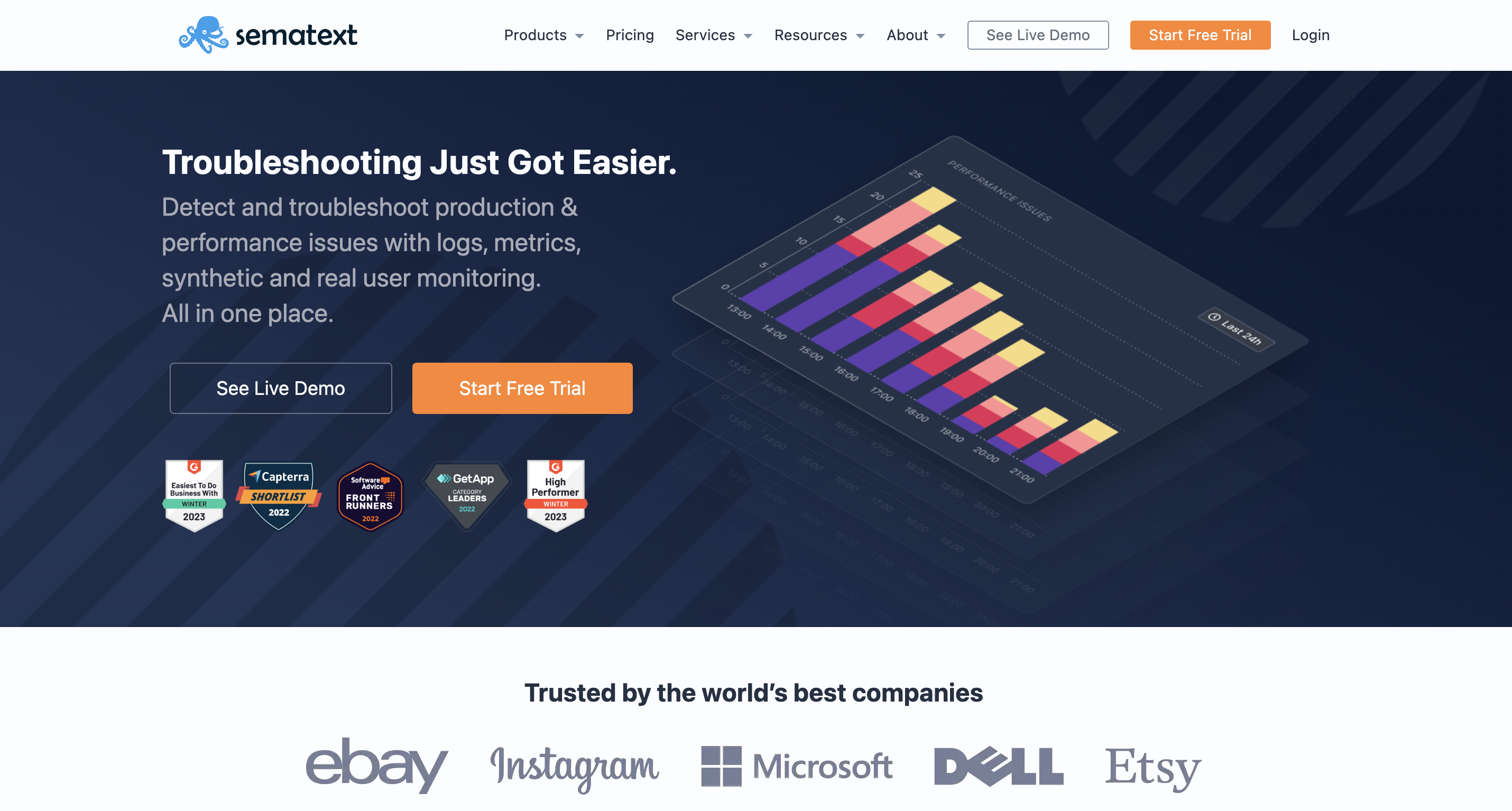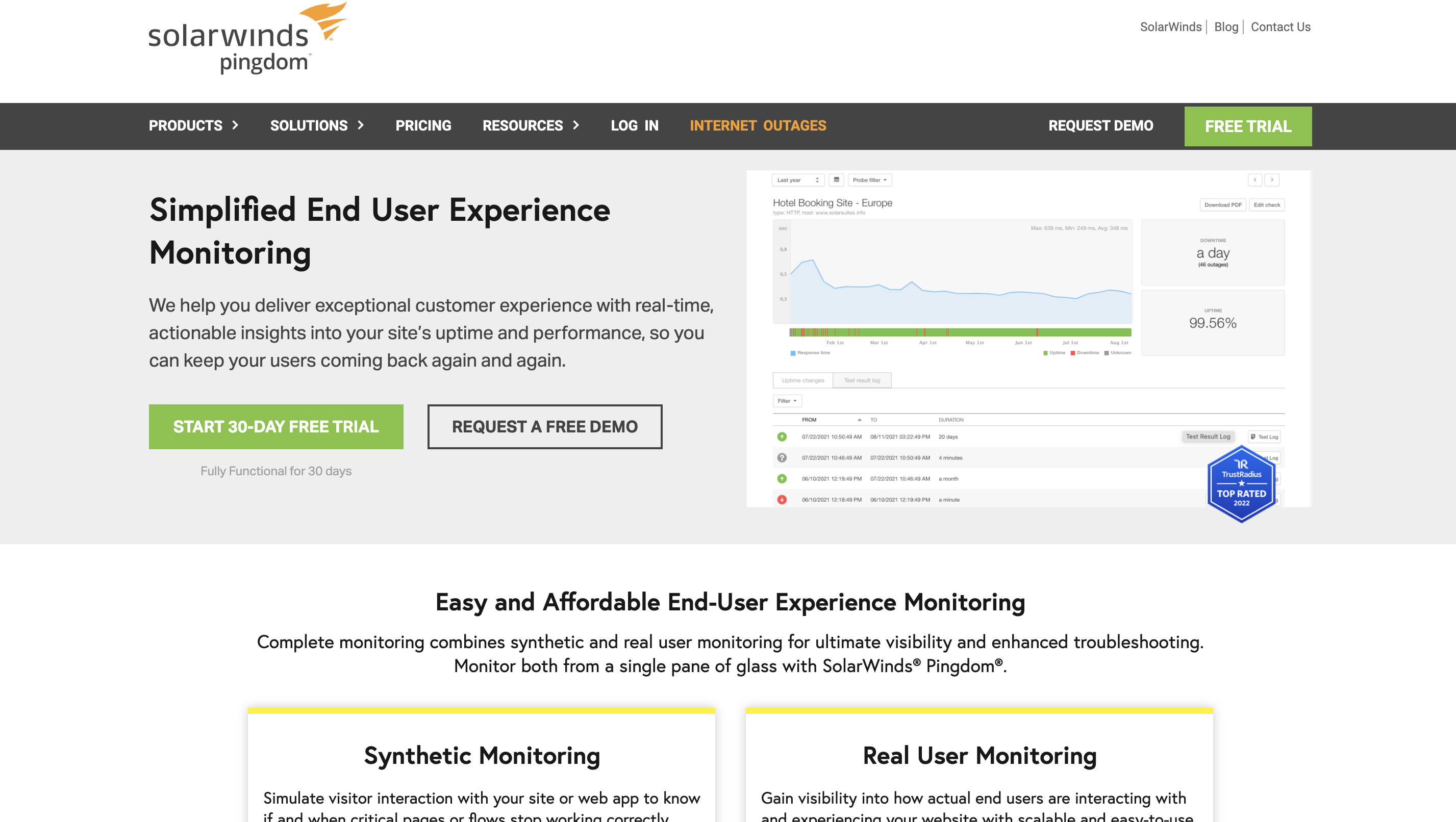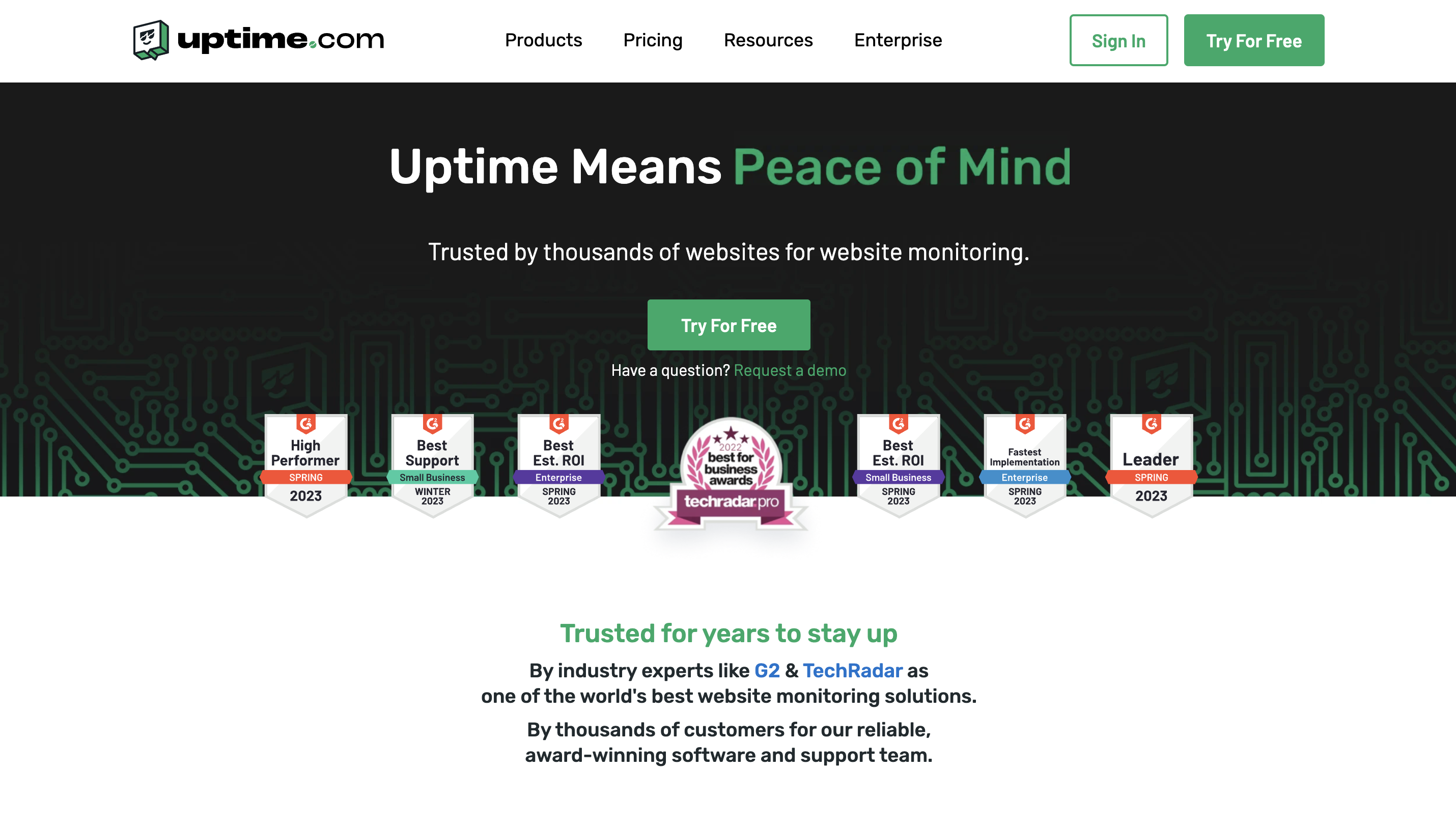Quick links
In today’s digital landscape, where websites and online services play a crucial role in businesses’ success, having continuous uptime and optimal performance is of the utmost importance.
This is where website monitoring tools come into the picture. Monitoring tools act as our vigilant sentries, constantly watching over our websites, servers, and applications to detect any issues that may affect their availability or performance.
By promptly identifying and alerting about problems, website monitoring tools enable businesses to minimize downtime, maintain a seamless user experience, and protect their online reputation.
Benefits of Using Reliable Website Monitoring Tools
Reliable website monitoring tools offer a wide range of benefits that give businesses the ability to proactively manage their online presence.
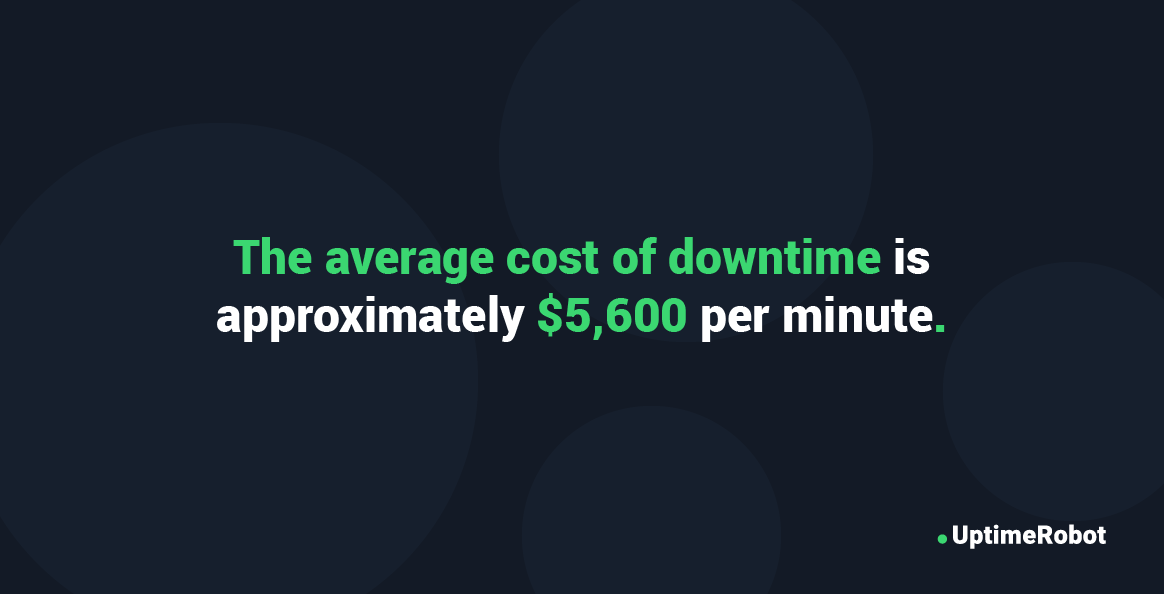
Here are some of the benefits you get when you choose the right monitoring tools for your business:
- Early issue detection: Website monitoring tools continuously track various aspects of your servers, applications, and websites, allowing for the early detection of potential problems. By identifying issues such as server outages, slow response times, or broken links, your team can take immediate action to rectify them before they impact your users.
- Minimized downtime: Downtime can be costly! You could experience revenue loss, damaged customer trust, and even negative brand perception. With website monitoring tools, businesses can swiftly respond to downtime incidents, reducing their duration and staving off any potential negative consequences.
- Enhanced performance: Website monitoring tools provide valuable insights into website and application performance, highlighting areas that need optimization. By monitoring response times, page load speeds, and transaction flows, businesses can identify bottlenecks and improve overall user experience.
- Improved user satisfaction: When websites and applications perform optimally, users have a positive experience and are more likely to engage, convert, and become loyal customers. Website monitoring tools help maintain a high level of user satisfaction by helping to provide continuous availability and optimal performance.
How to Choose the Right Monitoring Tool
With so many top-tier tools on the market (and in this article!), it may be difficult to choose which one will best suit your needs. Before choosing a monitoring service, consider the following aspects and rest assured that you will be making a more informed decision.
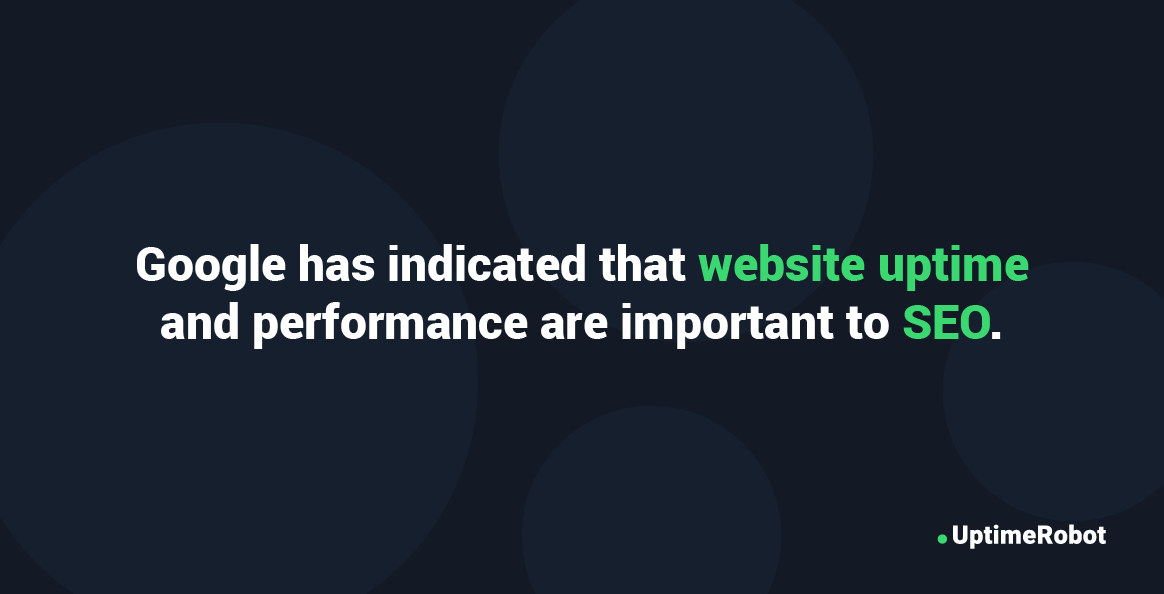
Define your monitoring requirements and objectives
Before selecting a monitoring tool, it’s essential to clearly define your specific monitoring requirements and objectives.
Consider what aspects of your online assets you need to monitor, and determine the metrics you want to track, such as uptime, response time, or transaction flows. After identifying your monitoring needs upfront, you will be able to narrow down the options, and choose a tool that aligns with your specific goals.
Consider ease of setup and use
The ease of setting up and using a monitoring tool is crucial for smooth implementation and easy ongoing management. Look for tools that offer intuitive interfaces and user-friendly configurations.
Scalability and flexibility for growth
As your business evolves, your monitoring needs may change and expand. It’s essential to choose a monitoring tool that can scale alongside your growth. Look at the tools’ websites to determine if it can accommodate an increasing number of monitored assets and handle growing traffic or user loads.
Integration capabilities
To maximize the efficiency of your monitoring operations, be sure to look at the integration capabilities of the tool with your existing systems and workflows. Check if the tool can work with your preferred platforms, including cloud providers, content management systems, or collaboration tools.
Easy integration allows for data consolidation and streamlines incident management, providing a cohesive and copacetic environment for all your programs.
Pricing and value for money
Monitoring tools come with various pricing models, such as subscription plans, tiered pricing, or pay-as-you-go options. Assess the pricing structure and the value for money offered by the tool. Remember to consider long-term costs, such as additional charges for scaling or extra features!
Reputation and customer reviews
Like with that new pizza place that just opened down the street, you’ll want to check the reviews before you buy. Research the reputation and customer reviews of the website monitoring tools you are considering. You can also look for testimonials, case studies, or reviews from other businesses in your industry or with similar monitoring requirements.
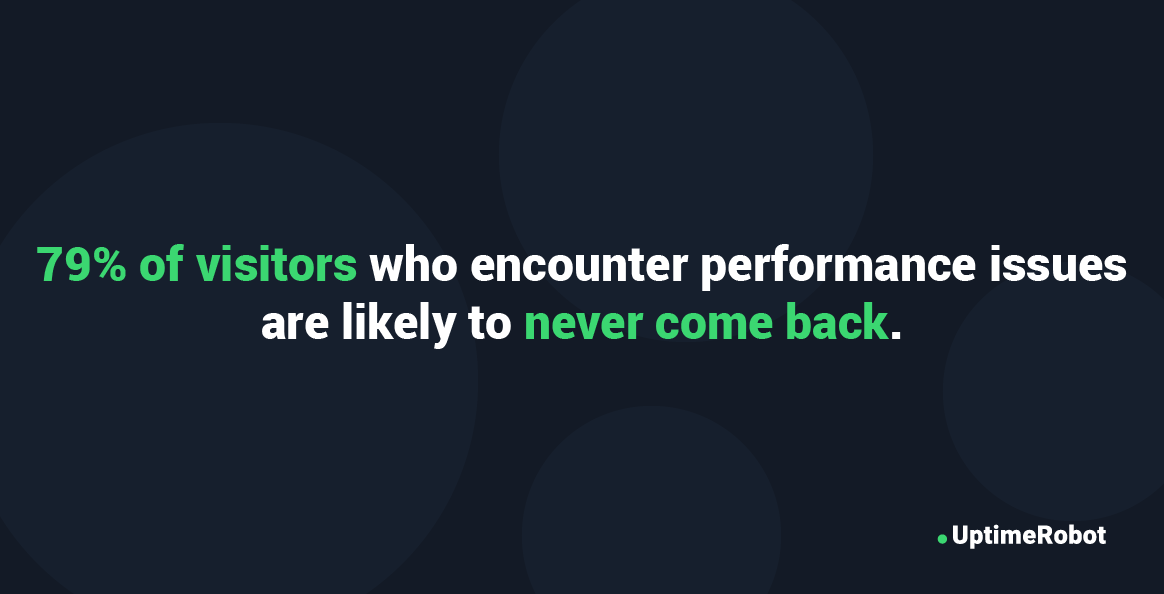
Security and data privacy
When monitoring your online assets, protecting the security and privacy of your data is paramount. Evaluate the security measures implemented by the tool, such as encryption, access controls, and compliance certifications.
By considering these factors when choosing a monitoring tool, you can make an informed decision that aligns with your specific monitoring needs, provides ease of use, scalability, integration capabilities, value for money, reliable support, and protects the security and privacy of your data.
Top 10 Website Monitoring Tools of 2023
UptimeRobot
UptimeRobot is a leading monitoring tool that has established itself as the go-to choice for businesses of all sizes. Boasting a robust feature set and extremely reliable performance, UptimeRobot has garnered a reputation for excellence in the industry. Let’s explore some of its key features.
Real-time monitoring of websites, servers, and others
UptimeRobot specializes in real-time monitoring, which keeps businesses updated on the availability and performance of their websites, servers, ports, APIs, specific keywords, or devices connected to the Internet. You can also monitor any SSL certificate errors and expirations and see the response time of your website.
By constantly monitoring these crucial components, UptimeRobot detects any downtime or performance issues promptly, allowing businesses to take immediate action and minimize disruptions.
Comprehensive and modern status pages
UptimeRobot allows you to showcase your uptime and share important updates regarding ongoing incidents or planned maintenance. Thanks to status pages customized to your needs and branding you’ll save time and costs related to each downtime. The subscribe to updates feature will let your users receive email notifications about every update and announcement on your status page.
Advanced alerting and notification options
When it comes to timely incident notifications, UptimeRobot excels. It offers a wide range of up to 12 alerting and notification options, including email, SMS and Voice alerts, push notifications, and integrations with popular communication channels and social platforms like Slack. Microsoft Teams, Twitter, Discord, and many others. These alerts help businesses respond quickly to any issues, and promptly notify the right personnel.
UptimeRobot’s competitive advantage in the market
| Feature | Description |
| User-friendly interface | ✅Easy-to-use interface for businesses with varying technical expertise |
| Straightforward setup | ✅Simplified setup process for quick onboarding and minimal technical know-how |
| Constant innovation | ✅Continuously updated with the latest industry trends and technologies |
| Customer satisfaction | ✅Dedicated to meeting user needs and ensuring high levels of satisfaction |
| Reliable monitoring | ✅Monitors websites, servers, and services for uninterrupted uptime |
| Multiple monitoring | ✅Capable of monitoring multiple targets simultaneously |
| Alerting mechanisms | ✅Provides real-time alerts via email, SMS, and popular messaging platforms |
| Downtime notifications | ✅Instant notifications when website or service downtime is detected |
| Performance metrics | ✅Tracks and reports crucial performance metrics for informed decision-making |
| Maintenance windows | ✅Schedules and manages maintenance windows to minimize disruptions |
Interested in UptimeRobot? Sign up for free today to start monitoring your website like a pro!
Uptimia
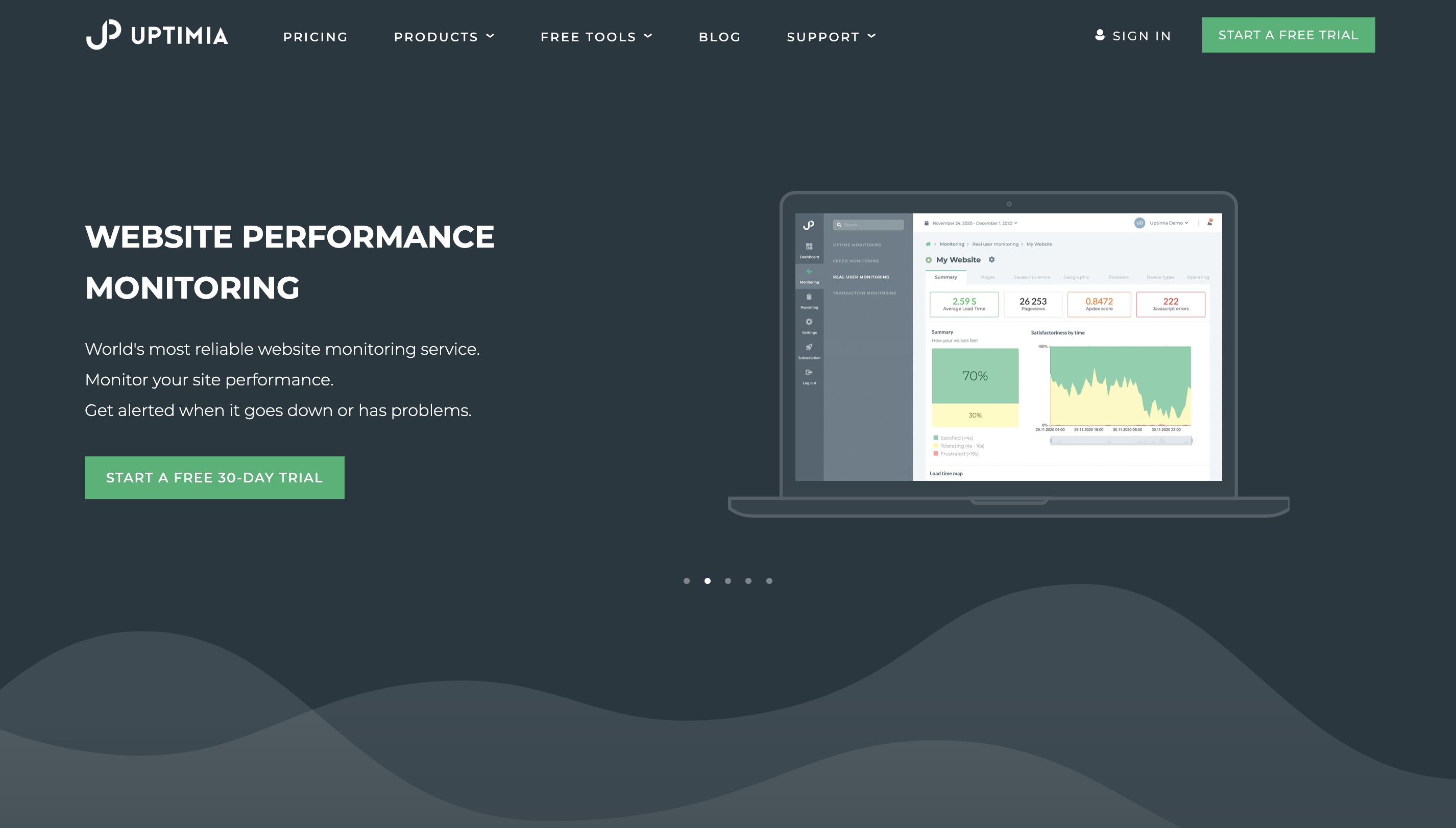 Uptimia is a comprehensive monitoring tool that specializes in monitoring website uptime and response time. It provides businesses with real-time insights into the availability and performance of their websites.
Uptimia is a comprehensive monitoring tool that specializes in monitoring website uptime and response time. It provides businesses with real-time insights into the availability and performance of their websites.
One of the standout features of Uptimia is its synthetic monitoring functionality, which allows businesses to simulate user interactions and transaction flows on their websites. By emulating real user scenarios, Uptimia helps users proactively identify potential bottlenecks and other issues.
In addition to monitoring, Uptimia offers performance testing and optimization recommendations, which allows users to conduct tests to assess their website’s performance under various conditions. Based on these tests, Uptimia provides actionable recommendations for optimizing website speed, responsiveness, and overall performance.
Uptimia’s monitoring capabilities provide businesses with a holistic understanding of their website’s performance. With this set of features, businesses can take measures to improve user experience, minimize downtime, and maximize customer satisfaction. Uptimia has definitely proven itself to be a valuable tool for businesses seeking to optimize their website’s performance and enhance their online presence.
| Pros | Cons |
| ✅Offers real user monitoring | ❌Pricing can be higher compared to some other tools. |
| ✅Global network of monitoring stations | ❌Lacks some advanced integrations |
| ✅Provides both website and server monitoring | ❌The user interface can be complex for beginners |
| ✅Supports multiple protocols and web transaction monitoring. | ❌Mobile app may lack some features found on the desktop version |
| ✅Multi-step transaction monitoring available |
Statuscake
Statuscake is a versatile and reliable monitoring tool designed to help businesses monitor the performance and availability of their websites and servers. Using this full suite of features, including website monitoring with a global network of test locations, server monitoring, SSL certificate checks, and page speed monitoring, Statuscake provides businesses with valuable knowledge about their online assets.
Its user-friendly interface and additional features like domain expiry monitoring, DNS monitoring, and real user monitoring make it a comprehensive solution for businesses of all sizes.
Statuscake’s monitoring capabilities provide businesses with the tools they need to effectively monitor their websites and servers. With features such as global website monitoring, server monitoring, SSL certificate checks, and page speed monitoring, businesses can identify and address performance issues promptly.
Overall, Statuscake is a reliable and well-rounded monitoring solution that helps businesses maintain an optimal website and server performance, ensuring customer satisfaction and business success.
| Pros | Cons |
| ✅Broad set of monitoring types | ❌Can be difficult to navigate for beginners |
| ✅Free tier available | ❌The free tier has limited features |
| ✅Push notifications to mobile apps | ❌Premium features can be costly |
| ✅API available for integration purposes | |
| ✅Detailed reporting and logging |
Datadog
Datadog is a monitoring and analytics platform that provides businesses with deep insights into their infrastructure, applications, and logs. Users can gain real-time visibility into the health and performance of their servers, containers, and cloud services.
The platform stands out in infrastructure monitoring by allowing businesses to monitor key metrics, identify bottlenecks, troubleshoot issues, and optimize resource allocation for reliability and scalability. In addition, Datadog offers powerful application performance monitoring (APM) capabilities, enabling businesses to monitor the performance of their applications and services.
The platform’s log management and analysis features provide businesses with the ability to collect, centralize, and analyze logs from various sources, gaining valuable insights, detecting anomalies, and troubleshooting issues for improved system reliability and security.
Datadog’s all-inclusive ecosystem and wide range of integrations further enhance its capabilities. It also integrates with popular tools and platforms, consolidating data and providing a unified monitoring experience.
| Pros | Cons |
| ✅Offers a complete observability suite, not just uptime monitoring | ❌Requires technical knowledge for optimal setup and usage |
| ✅Strong integration support with various platforms and services | ❌Some users find the alerting system to be non-intuitive |
| ✅Machine learning-based anomaly detection | ❌More expensive compared to more focused monitoring tools |
| ✅Excellent data visualization capabilities | |
| ✅Supports auto-scaling and dynamic infrastructure |
Uptrends
Uptrends is a trusted provider of monitoring solutions designed to ensure website availability and performance for businesses. With a global monitoring approach, Uptrends allows businesses to learn about their website performance from different locations around the world.
One of Uptrends’ special features is its transaction monitoring capability, which allows users to simulate user interactions and monitor the performance of online processes. This functionality helps identify bottlenecks and optimize conversion paths, ensuring smooth user experiences and maximizing conversions. Additionally, Uptrends offers robust API monitoring to track the availability and performance of APIs, ensuring seamless integrations and detecting any latency issues.
Uptrends sets itself apart with a user-friendly interface, a global network of monitoring locations, and a strong focus on customer satisfaction. Uptrends’ commitment to their customers is reflected in positive reviews, highlighting its reliability and responsive customer support.
| Pros | Cons |
| ✅Offers waterfall reports for performance monitoring | ❌Lacks a free plan |
| ✅Good geographical coverage for monitoring checkpoints | ❌Can be expensive for smaller businesses |
| ✅User-friendly interface | ❌Limited customization options in the lower-tier plans |
| ✅Multi-browser monitoring available | |
| ✅Robust API for integrations |
Uptime Kuma
With Uptime Kuma’s customizable checks and advanced monitoring capabilities, this excellent monitoring tool offers businesses the ability to watch specific metrics and thresholds to ensure optimal performance. Its real-time monitoring of response times, server health, and DNS resolution enables businesses to address issues promptly and maintain uptime.
A feature that makes Uptime Kuma an excellent choice is its synthetic transaction monitoring, which allows businesses to simulate user interactions, and monitor end-to-end transaction flows. This functionality is particularly valuable for e-commerce businesses and critical processes.
Uptime Kuma also provides a range of alerting and notification options tailored to businesses’ specific needs, which means timely awareness of any incidents or performance issues.
So, with its user-friendly interface, competitive pricing structure, and positive customer testimonials this tool is a great choice for many. Businesses of all sizes and technical expertise can easily set up and navigate the tool, while customizable monitoring options and responsive customer support add to its reliability.
| Pros | Cons |
| ✅Open-source and self-hosted, providing full control over data | ❌Limited in built-in integrations |
| ✅Supports a variety of alert methods | ❌Being self-hosted, availability depends on user’s infrastructure |
| ✅No subscription fees | ❌Being self-hosted, availability depends on user’s infrastructure |
| ✅Easy to set up, but… | ❌Requires some technical know-how to set up and maintain |
| ✅Provides system metrics |
Site 24×7
Site 24×7 offers businesses a unified platform to monitor their websites, servers, and networks. With its diverse range of features, businesses can effectively track uptime, performance, and user experience metrics.
Site 24×7’s end-user monitoring capability focuses on web applications and SaaS products, allowing businesses to optimize the user experience by simulating user interactions and capturing data on response times and availability.
Additionally, Site 24×7 extends its monitoring capabilities to the cloud, which lets users monitor and manage their cloud infrastructure, applications, and services across multiple cloud providers.
These features combined provide businesses with the assets they need to monitor, manage, and optimize their online assets and IT infrastructure effectively.
| Pros | Cons |
| ✅Offers a broad set of monitoring capabilities including real user monitoring. | ❌Interface can be complex for beginners |
| ✅Has a strong feature set for application performance monitoring | ❌Higher-tier plans can be expensive |
| ✅Infrastructure monitoring capabilities | |
| ✅Detailed reporting capabilities | |
| ✅Provides synthetic transaction monitoring |
SemaText
SemaText offers comprehensive monitoring and log management solutions that empower businesses insight into their infrastructure, applications, and logs. With its advanced features and user-friendly interface, SemaText has become a well-loved choice for businesses seeking strong monitoring and log management capabilities.
Its solutions include infrastructure and server monitoring, application monitoring with distributed tracing, and log management and analysis. SemaText users can optimize performance, troubleshoot issues efficiently, and enhance overall reliability. SemaText’s unique features, such as real-time monitoring, a large range of metrics, and affordability, make it an attractive option for businesses of all sizes.
| Pros | Cons |
| ✅Combines infrastructure, real user & synthetic monitoring | ❌Can be complex for simple monitoring needs |
| ✅Offers log management and analytics | ❌More expensive for large volumes of data |
| ✅Strong support for Docker and Kubernetes monitoring | ❌Limited options for free tier |
| ✅Provides transaction tracing | |
| ✅Flexible alerting mechanisms |
Pingdom
Pingdom is a reliable tool for tracking the uptime and performance of websites and online services. With its comprehensive suite of monitoring features, including website uptime and performance monitoring, transaction monitoring, real user monitoring, and page speed insights with optimization recommendations, Pingdom provides businesses with valuable insights and tools to optimize their online presence.
Its global network of monitoring locations lets businesses track their website’s performance from various regions, enabling proactive measures to minimize downtime. Pingdom’s reputation as a leading monitoring tool and its user-friendly interface have made it a popular option for businesses seeking reliable and all-in-one monitoring solutions.
| Pros | Cons |
| ✅Real user monitoring capabilities | ❌Some users find the pricing to be on the higher side |
| ✅Provides transaction checks | ❌Limited integrations with other platforms compared to competitors |
| ✅Page speed monitoring features | ❌Reporting options could be more comprehensive |
| ✅Offers a mobile app for on-the-go monitoring |
Alertra
Reliable and effective, Alertra is a monitoring tool specializing in uptime and performance. With its advanced monitoring capabilities, businesses can quickly detect and address potential issues to better provide a trouble-free user experience.
Alertra’s global network of monitoring locations provides a comprehensive view of online assets, helping identify regional variations, network outages, or latency issues. The tool’s advanced alerting and notification system helps businesses take immediate action when issues arise, minimizing downtime and performance disruptions.
Its detailed reporting and analytics offer valuable insights for optimizing performance and enhancing the user experience. With its exceptional reliability, accuracy, and user-friendly interface, Alertra is regarded as a trusted monitoring solution in the industry, backed by outstanding customer support.
Bonus tool to consider: Uptime.com
Uptime.com is a leading monitoring tool that offers comprehensive solutions for businesses to improve the uptime, performance, and reliability of their websites, servers, and online services.
The tool specializes in website and server monitoring, providing real-time insights into availability and performance from various global locations. It also offers transaction monitoring and user scenario testing to simulate critical user interactions and confirm proper functionality.
Uptime.com, like others on this list, combines synthetic monitoring and real user monitoring to provide a full view of website performance by analyzing data from simulated visits and actual user visits. Its alerting and notification system keeps businesses informed of potential issues, allowing quick responses and mitigating the impact of downtime.
In summary, Uptime.com’s monitoring solutions encompass website and server monitoring, transaction monitoring, and synthetic, and real user monitoring. Its robust features, reliable performance, and customer-oriented approach make it an excellent choice for businesses seeking comprehensive monitoring and performance optimization.
| Pros | Cons |
| ✅Comprehensive feature set for website monitoring | ❌Pricing is a bit higher than some competitors |
| ✅Provides real-time alerts | ❌The free trial period is relatively short |
| ✅Detailed reporting features | ❌Interface can be a bit complex for beginners |
| ✅Global monitoring locations | ❌Limited options for free tier |
| ✅Offers a public status page feature |
FAQ
What are monitoring tools, and why are they important?
Monitoring tools are software applications or services that help businesses track and measure the performance, availability, and uptime of their websites, servers, networks, and online services.
They continuously monitor these assets, collect data, and provide insights to help businesses detect issues, optimize performance, and provide top-notch user experiences.
Monitoring tools are crucial for businesses as they enable proactive management, early issue detection, and efficient troubleshooting, ultimately minimizing downtime and maximizing the reliability of online services.
How do I choose the right monitoring tool for my business?
When choosing a monitoring tool, consider the following factors:
- Your requirements and objectives
- Ease of use and setup
- Scalability
- Integration capabilities
- Pricing and value for money
- Reputation and customer reviews
- Security and data privacy considerations
Can monitoring tools help prevent downtime?
Yes and no.
While monitoring tools cannot directly prevent downtime, they play a crucial role in minimizing its impact. By continuously monitoring websites, servers, and other online assets, monitoring tools can quickly detect performance issues or outages. Businesses receive immediate alerts and notifications, allowing them to respond promptly and address the issues before they escalate. Timely troubleshooting and proactive management facilitated by monitoring tools help minimize downtime, and detect issues that may cause downtime in the future.
How often should I monitor my website or server?
The frequency of monitoring depends on the nature of your business, the criticality of your online services, and your specific requirements. In general, it is recommended to monitor your website or server continuously, with monitoring intervals as short as possible. Real-time or frequent monitoring allows for the earliest possible detection of issues, enabling quick response and minimizing the impact on users.
What types of metrics should I monitor?
The metrics to monitor will vary based on the assets and services you want to track. Some common metrics to consider include…
- Uptime
- Response time
- Page load time
- Error rates
- Transaction success rates
- Resource utilization
- Network performance
The specific metrics you monitor should align with your business goals, user expectations, and the key performance indicators (KPIs) relevant to your industry.
Can monitoring tools integrate with other systems or platforms?
Yes, many monitoring tools offer integration capabilities with other systems or platforms. Check your preferred tool’s website to learn more.
Disclaimer: The information provided on this page is for informational purposes only. Our rankings and reviews are based on our own research and analysis, aimed at providing unbiased, objective, and reliable information to our readers. Despite our affiliation, we strive to maintain objectivity and factual accuracy in our content.
However, we cannot guarantee that all information presented is up-to-date or entirely accurate. We encourage you to conduct your own research and consult with professionals before making any decisions based on the information found on this page. If you detect any inaccuracies, please do not hesitate to inform us.
